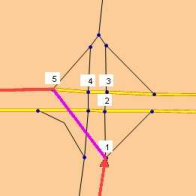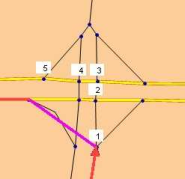Main turns are constituent parts of main nodes. They are created automatically when defining a main node and can be edited manually.
Main turns possess the same attributes as turns. They are automatically inserted or deleted when editing cordon links, i.e. when inserting or deleting cordon links and when editing the allocations to main nodes or relevant attributes (TSysSet, NumLanes).
Each movement via the main node is represented by a main turn. A main turn is therefore the transfer from one cordon link to another. If the main node consists of a single node only, the main turn corresponds to exactly the turn between the links concerned. It is thus a generalization of the usual turns at a node on the level of the main node.
If we reconsider the intersection area in Image 12, assuming that all displayed nodes were incorporated in a main node, seven cordon links exist. Since a main turn leads from each cordon link to each cordon link, there are 49 main turns at this main node. However, it does not make sense to traverse some of them, as they enter one-way roads in opposite directions (Main turns not open to traffic). Exactly the 16 (or 12, in case of closed U-turns) convenient movements via the main node remain the main turns that are open to traffic ( Main turns open to traffic).

Image 14: Main turns open to traffic

Image 15: Main turns not open to traffic
Within a main node the main turn completely takes the place of the network. This means that all traffic-related properties which take effect when crossing the main node are described exclusively by the attributes of the main turn and the main node. A path that crosses the main node only uses the main turn between the incoming and the outgoing cordon link. Neither the attributes of the (inner) links, nodes and turns in between are evaluated, nor will these network objects be loaded during assignment.

